Raylight
Cutter Quick Start Guide
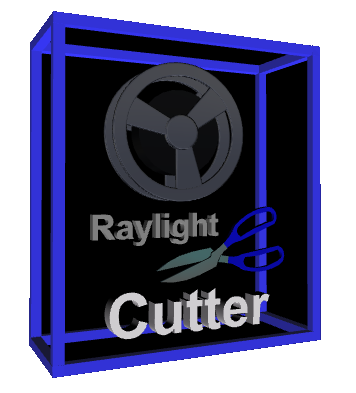
by
Marcus van
Bavel, BSEE
DVFilm.com
A series of videos
on YouTube exist to guide the user through installation and setup of Raylight
Cutter. They can be found at dvfilm.com/help and click on Tutorials, or by searching
YouTube for “Raylight Cutter”. Here is a direct link: youtube.com/user/dvfilmsupport
Installation
When you purchase
the program, a download link is emailed to you. Download the file and double-click
on it to run the installer.
Helper Apps
The installer will
guide you through the installation process. Several helper programs are used
with Raylight Cutter. These are all free programs available on the Internet.
The installers are included with Raylight Cutter for your convenience. Some of
these helper programs may not be required. The best procedure is to select all
of them, then later, remove the ones that are not used, with Windows Control
Panel, or on OSX by deleting the application icon from the Applications folder.
Only the first one (Microsoft Visual C Runtime) is absolutely required, for
Windows only. Also if you have previously installed Raylight Cutter, you can
skip all of them. For a detailed explanation of the helper files and what they
are used for, see dvfilm.com/cutter/helpers
Activation (Purchased Version Only)
Skip this section
if you are running the demo version.
When the installer is
finished, you will be prompted for your serial number, email address and
activation code. If you do not know your serial number, you can request it by
pressing Request Serial Number (the computer must be connected to the Internet
for this step). The serial number is emailed to you. If you need your
activation code, click Request Activation. The activation number will be filled
in assuming the email address and serial number are correct (this also requires
the computer to be online).
If your computer is
off the Internet, there is another activation method that involves using your
smart phone. To use that, point your phone’s web browser to dvfilm.com/mobile,
click Help and then Activate Software. A full explanation of offline
activation, including a video tutorial, can be found at dvfilm.com/help under “Serials
and Activation”.
Home Screen

The home screen
presents you with the three phases of film making: selecting clips (the camera
icon), editing the project (the reel icon) and presentation (the projector
icon).
The date and time are displayed in the upper
left-hand corner.








Choose the camera
icon to get started. Click on the rotating camera to open it and select file
format.
Selecting
Clips

After the camera
turns, choose the file format that your camera
records, or any format of interest that you wish to use in your proect, by clicking on the appropriate tile.
|
Import File Formats |
|
|
|
|
|
P2HD |
MXF files created
by Panasonic P2 cameras |
|
XDCAM |
MXF files used by
Sony Cameras |
|
Canon |
MXF files
recorded by Canon cameras |
|
MPEG |
Any Mpeg file
(.mpg, .m2t, .mp4 etc.) recorded by many different cameras |
|
AVC |
MTS and AVC files
used by several camera makers recording in the H.264 stream format |
|
Red |
R3D raw files
used by Red Cameras (not in Beta release). |
|
QuickTime |
QuickTime files
used by DSLR cameras, iPhone cameras, and many
others |
|
Windows Media |
WMV, WM9, AVI
files, etc. used on Windows platform |
|
Import File Formats (cont) |
|
|
|
|
|
RAW |
A variety of Raw
formats from electronic cinema cameras (not in Beta release). |
|
Audio |
AIFF, WAV, and
MP3 files usually exported from other programs |
|
Stills |
JPG, TIFF, BMP, PNG,
DPX files and other frame sequences usually exported from other programs |
|
Plug-in |
Any file format
supported by DirectShow or a Raylight Cutter 3rd-party plug-in. |
Raylight Cutter will
then search your hard drives for clips of that format. It searches by file
extension. The areas searched are:
1.
Your
system drive Media folder (usually C:\Media). On OSX this is the system drive,
Media folder. This folder is created by Raylight Cutter on installation and it
puts a couple of sample files in a Samples subfolder. Except for this folder
and the user’s home folder (including the desktop) the rest of the system drive
is not searched.
2.
Any
other connected hard drive, starting in the root folder. Up to 6 levels of
subfolders are searched. This subfolder limit can be changed, see “Customizing
Raylight Cutter”.
3.
The
user’s home folder (Documents, Videos, the Desktop, etc).
4.
If you
don’t want a folder searched, rename the folder with a minus sign in front of
the folder name. If you have folders on the root of your system drive and want
them searched, move them to C:\Media.
5.
The
search can take a long time, but it is done only once for each type of file
that you work with, and then Raylight Cutter remembers where they are. If you
add folders of media files to your system, you can use the refresh icon to redo
the search and find those folders.
Folder
selection

All folders
containing media files of the type you selected (in this example above, still
image files) are shown. If there are more folders than can fit on the screen, use
the up and down arrows to flip through the folders.




To delete a folder, drag it to the trash
(feature not in Beta release). To add an empty folder, click the add folder
icon (not in Beta Release).


Click on a folder
to open it.
Click on the gray
tile behind the folders to push back to the format selection screen, to select a
different clip format.
Clip
Selection

When the folder is
open, all the clips of the selected format (in this case, P2 MXF files) in that
folder are shown. Beneath each clip is the file name
in white, and the metadata user clip name in violet. The metadata category can
be changed by clicking on the metadata icon (the violet “M”) and then using the
up and down arrows that will appear in violet. Clips can be alphabetized by file
name or metadata. Typical metadata includes starting timecode,
date, format, location, scene and take number, camera
person’s name, etc.
Drag a clip to the
trash to delete it.
Drag a clip into
the project (the reel-shaped piechart) to add it to
the project.
Drag the clip into
the background (black area) to create a floating clip. The clip will remain
floating there until you put it somewhere, or remove it by dragging it into the
trash.
Flicking Clips
(Flicking clips is not
in the Beta release). This allows you to use a gesture on the touchscreen or a gesture with the mouse, to direct the clip
into the reel or into the floating clip area. Flick the clip up, right or down,
to create a floating clip (anywhere but in the direction of the reel). Flick
the clip in the direction of the reel to insert it at the end of the current
reel. With the mouse, flicking is accomplished by dragging across the clip, or
from the clip, and then releasing the mouse button somewhere beyond the clip
(the exact position does not matter).


Click on a clip to select
it and open the viewer.
Viewing a
clip

The above screen
shows the clip viewer after you have clicked on a specific clip in the folder.
Changing the 3D
Position of the Viewer
You can use the
SHIFT key and the mouse (but it’s not necessary to click on the mouse) to move
the clip viewer around on the screen, left/right and up/down. Use the CTRL key and
mouse up or down to move the viewer closer or further away, or left/right. Or
you can click and drag (or touch and drag) the right or left-hand side of the
viewer frame to move it around (feature not in Beta release). You can do this
from anywhere on the frame as long as the finger or mouse is not on one of the
6 controls on the frame.




The longer the
crank arm, the finer you can position the viewer forward or backward in time.
When the crank arm is short you can scan through the footage quickly.
Click the play button
to play the footage, starting at the last place you left it. If you pause the
playback, you can resume from there by clicking the pause button again, or the
play from start button (which will appear to the left of pause) to start from
the head cut.




Trimming the Clip


In this way the
clip can be trimmed before dragging it into the reel. Most editing functions
(trimming, sound levels, steering, color correction,
titles, adding tracks of music or adding sound effects) can be done before the
clip is dragged into the project, and the changes will accompany the clip when
it is copied over.
Speeding up
Playback
with the Lightning Bolt


The Lightning Bolt
is recommended for all MPEG and H.264-based material, 2K, 4K, and uncompressed
media, depending on the speed of your computer system, to get real-time
playback of the edited reel.
While the proxy is
being made, the lightning bolt will slowly fill up from bottom to top. When it
flashed and turns all white, the proxy is finished. You can do other things
while the proxy is being made. If you minimize or iconify
the Raylight Cutter window, the proxy is built faster. The title bar of the
window also shows the progress of making the proxy, in frames made divided by
frames total. You can also see the progress info, if the window is minimized,
by hovering the mouse over the window icon. If you
click on the lightning bolt while a proxy is being made, it will halt the
proxy-making function. If you click again, or after the proxy is done, it will
delete the proxy. Proxies are made from the start of the media to the end. You
can also make a proxy just from the head to tail clip (feature not in Beta
Release) by dragging from the selected area (blue area) of the clip to the
lightning bolt icon.
The low-res proxy
will not affect the quality of your finished movie, it
just makes editing faster and easier. To control the quality and resolution of
the proxy, see “Customizing Raylight Cutter” page xxx.
Snapshot or Thumbnail


The still image of the clip
is visible in the miniature clip view, and in the reel, if the clip is in the
reel.
Add Title


Press the return
key to go to the second line. Click outside the viewer to stop adding text to
the title. It’s possible to control the
position, size, color, transparency, scrolling, and font of the title. Click the
title icon (“Tt”) to open the title controls. You can
also create a title or any superimposed image in an external paint or
photo-retouching program. When you drag a clip to the project, the title will
go with it. If you need multiple titles over one shot, this is usually done
with a subreel (of superimposed clips). See Titles for more detail.
Color
correction, Visual Effects,
and Re-Framing
Click on the
Rembrandt icon (the red/green/blue-colored circle) to color correct the clip.
The Rembrandt system uses the keyboard for most functions. For example the
numeric keypad 8 key raises gamma (increases brightness) and the numeric key 2 lowers the gamma. Rembrandt can be used to add green-screen
matte effects, create film looks with grain and gate weave, change selected
colors in the frame, reposition the frame, stabilize motion in the frame, and
has many other features. All settings can be “key-framed” (animated) with
smooth transitions. Rembrandt also works with the Griffin PowerMateTM
controller and can be entirely controlled from the PowerMateTM.
See the Rembrandt
section for details.
Audio
Editing

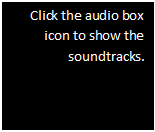


Select a track by clicking on it.
Click on the black area to unselect all tracks.
Click on the gears to the left of
the track to unlock a track from the picture track. Click the gears again to
lock them. When a track is unlocked, it will remain in place while the picture
track is moved forward or backward.
Syncing a
track
This is how you sync an audio track
to the picture track (not needed if the audio was recorded with the video).
With the track locked, use the
crank arm or drag along the track to position the track to a loud or distinct
sound. Unlock the track. Crank or drag the picture track to the where the sound
is supposed to occur. Then lock the track again.
Controlling
Audio Cut Ramps
To control the ramp length of an
audio cut (the time over which the sound is blended in at the head and tail
cuts), after you make the cut with the scissors, drag a crank arm out of the
speaker box and use it to adjust the ramp length (not working in Beta release, all cuts
are ramped in 0.1 sec).
Changing
audio levels
A volume change can be made to the
entire track by dragging a crank arm out of the global audio icon (looks like the
Earth) and turning it. The audio waveform turns cold (more blue) for lower
volume and hot (yellow) for higher volume. Peaks will be highlighted in red if
the volume is too hot. When playing back a track, the audio peak meters will
highlight red and stay red if the track is over-modulated. Crank the track to the loud parts and reduce
the volume to avoid distortion. Cutter also has a feature which will
automatically limit or soft-limit the volume before the tracks starts peaking
(not in Beta release).
Changing volume over a small patch
Move the track so the sound you
want to change is centered. A crank arm
can be dragged out of the local volume control (crosshair icon) to change a
small part of the track. Turn the arm to raise or lower the volume, drag the
crank arm out to enlarge the region around the center of the track. The
two-digit counter shows how many places in the track you have done this. Drag
black into the audio box to clear any volume changes.
Audio
Surround Steering
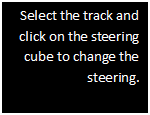

Click on a corner of the cube to
direct the sound to a corner. Click the top, bottom or side edges to center it
front, back or side. Click the middle to direct the sound to the subwoofer or
to mute it.

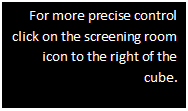
The screening room will open and
allow you to fine adjust the steering between the speakers.

The
Screening Room
Click and drag along the walls or
the floor of the room to move the audio location. Click and drag the arrows to
re-orient the room. Use the play button to preview the track (only the track
you selected will play). Click the “X” to close the steering room.
Audio Effects
Audio Effects built in to Cutter
include reverb, equalization, limiting (compression), pitch change, and noise
reduction. The audio effect is selected by clicking on the speaker icon in the
audio box (this feature is not provided in the Beta Release).
External
Audio Editing
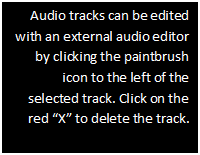

If you click the paintbrush a copy
of the track will be made and then opened with the default audio editor. If
Audacity is the default editor, after making changes the track must be exported
back to the copy. The file is located in the Cutter subfolder with the original
source clip.
Other editing programs may be used
such as Goldwave, Sound ForgeTM,
ProToolsTM, etc. See “Customizing Raylight Cutter.”
Key-frame Volume changes or steering
The Rembrandt controls can be used
to key-frame any volume, effect, or steering changes. See the Rembrandt section for
more details. (In the Beta release, only volume changes can be key-framed).
Adding a
Subreel
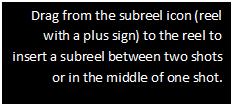

If a subreel is in the middle of a
shot, the video is superimposed over that shot (and any others in the reel that
might follow). If the subreel is inserted, or dragged into slug, the reel is
inserted as a scene within the reel. Subreels can be nested to create a
hierarchy of reels, acts, groups of scenes, or scenes within the movie. You can
also move a subreel or make a copy of it by dragging the subreel to the black
area (the cutting room floor) to create a floating reel. Floating reels can then
be moved anywhere within the reel or subreels. They are also automatically
saved in the library.
Naming a Reel or SubReel
A reel (or subreel) can be named by
clicking on the name tag under the reel and entering a name. Press enter or
click outside the nametag to set it. Press the escape key to cancel any change.
Adding Slug
or Blank Footage
Drag from black to add slug to a
reel. Slug is black video that can have titles or added audio tracks. The Rembrandt
controls can be used to create colored or semi-transparent slug. The head and
tail cuts can be used to change the length of the slug.
Using the
Library and Navigating through a Project

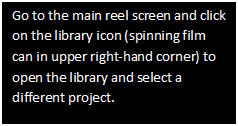
A new, empty project can be started
by dragging the edge of the reel to the trash can. The existing project will be
saved before the reel is cleared out. Reels are saved automatically as you edit
them, so there is no need to save a reel. However you can force Cutter to save
a reel by clicking the hard drive icon in the lower right corner.
Undo
Changes with Walkback
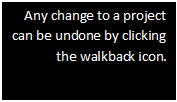

If you made a series of mistakes
and want to backtrack the project to an earlier date,
you can also copy the backup from the undo folder in the Documents/RaylightCutter/FilmVault
folder (or on the Mac, the /Users/Shared/RaylightCutter/FilmVault folder) to
the FilmVault folder. The backup files are named by project, date, and time of
the backup.
Packaging a
Project
A project can be packaged by clicking
on the package icon in the library screen. Select the folder, and then Cutter
will copy the project file and the associated media into to that folder. The
references in the project file are relative to the root folder of the package.
So the folder can then be moved or copied to any location, or onto another
computer, or to a backup drive. (This feature is not working in the Beta
release).
Adding and Editing Transitions
A video transition can be selected
by clicking on the border between two shots in the reel. The border will be
highlighted in violet, and the transition cube will rotate to the appropriate
transition. If the cube remains grey, the default transition (a hard cut, by
default) is used.




You can clink at the top of bottom
edge of the digits to change the length, or at the top or bottom edge of the
counter to change the length by 4 frames up or down. You can also drag a crank
handle off the counter and set an arbitrary length. The main 4 built-in
transitions are dissolve, flash frame, wipe, and clock wipe. You can also
select one of 100 additional transitions by dragging a crank handle off of the
cube (feature not working in Beta release).


The default flash frame color is
white.
For a wipe, the angle and width of the
wipe can be changed by dragging a crank handle from the half black/half white
ball icon. (Beta release can change the angle only).
To clear the transition, drag black
into it (or into the counter) and it will be set to a hard cut. To clear the
transition and set it to the default transition, click the trash can icon.
To set both the beginning and end
transition for a shot, click on the middle of the shot


To set both the beginning and end
transition of the reel, click on the black pie-shaped space between the last
shot and the first shot.
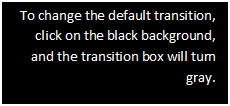

You can then click the cube and the
counter to set the default transition.
Superimposed
Music or Sound Effects
Details to be written. Superimposed music or sound effect tracks
can be made by dragging audio tracks from a folder or audio files or from the
clip viewer to a clip in the reel. The sync gear controls and scissors can be
used to synchronize and trim the sound effects or music.
The Main
Editing Screen
To open the main editing screen, click on the
reel in the home screen. Shots and transitions in the reel can be edited. To do
more detailed editing, click on the play button in the center of the reel, and and it will transition to the synchronizer view (see
below).
The
Synchronizer

In the synchronizer, clicking on a shot in the reel will open
the shot in the clip viewer. Clicking on the audio box will also show the
soundtracks. The viewer will also show any sound tracks from other clips in the
reel that overlap this shot. Those reference tracks will be shown with darker,
transparent color.
If the clip is in a superimposed subreel, scrubbing the
picture track with the crank arm or by dragging the mouse along the film strip
will show the selected clip superimposed over the parent clip. Hoever playing the clip by using the play button on the
viewer will show only the clip.
To change the opacity (or transparency) of a superimposed
clip, turn on the Rembrandt control and set the clip level with the “L” key.
If you have slug in the superimposed reel, the slug can be
made completely transparent by setting the level to -1.0.
50% transparency is equivalent to a level of -.5.
Synchronizing the superimposed track is accomplished by using
the blue gear box controls to the left of the picture roll. These are also
called the slip gears. To use them, first scrub or crank the selected clip to
the sync point. Release the slip gear. Then use the crank arm to position the
underlying layer (from the parent clip) to the sync point of the parent clip.
Then lock the tracks together. Using the blue slip gears will ensure that the
audio tracks will remain locked to the selected clip when it is slipped.
(Example to illustrate this function to be written).
Editing
Multi-Camera Shoots
Drag a subreel into the first shot (camera
“A”) of a main reel. Open the subreel by clicking on it. Drag a second shot
(Camera “B”) into the subreel. The A/B control in the synchronizer screen can
then be used to switch back and forth between A and B cameras, either during
live playback, or after scrubbing to an edit point. “C” camera clips can be
added as a subreel to the “Camera B” subreel, etc. When you click on the “A/B”
control, the default transition is used to transition between the shots. The
edit point becomes the middle of the transition. Transitions can also be
changed after the cut has been made (see Editing Transitions). More details to be added.
Project
Settings
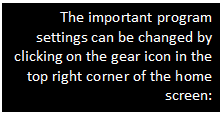

These settings are
default frame size, frame rate, etc. for exporting movies and also affect
conversions if you have a mix of formats in your project. You can skip this
step and change the settings later if you desire. They’re not important until
you export video, or start to work with sound mixing. See below.

The Settings Screen
The settings are:
Frame size – set
the default frame size when exporting. Click on the top half
of the polyhedron to increase the frame size, the bottom half to decrease it.
Frame rate – set
the project frame rate (the default frame rate when playing or exporting)
Frame system –
select US or EU (European) frame rate system. US rates are divided by 1.001 for
compatibility with NTSC and digital video systems (for example 29.97 instead of 30 frames/sec).
EU rates are exactly as shown.
Frame Aspect Ratio
– select 16:9 or 4:3
Audio Rate – select
48 KHz, 44.1 KHz or 96 KHz as the default export rate
Audio Bits – select
16 or 24 bits/sample as the default export format. If a format will only work
with 16 bits/sample this setting is ignored.
Audio Channels –
select no audio (no speakers), mono audio (one speaker), stereo (2 speakers),
or surround (6 speakers)
Graphics mode –
click the icosahedron to change the graphics mode to
non-textured or wireframe
How to
Organize Large Projects
To be written
Color
Correction with Rembrandt


The Rembrandt system uses the keyboard and
(optional) PowerMateTM for most functions.
Numeric keypad
These functions
always operate over the entire frame:
|
7
Raise Low Tones |
8
Raise Mid Tones |
9
Raise High Tones |
-
Lower Saturation |
|
4
Reset Low Tones |
5
Reset Mid Tones |
6
Reset High Tones |
+
Raise Saturation |
|
1
Lower Low Tones |
2
Lower Mid Tones |
3
Lower High Tones |
|
Low Tones, Mid Tones,
and High Tones are also known in video-speak as Black Level, Gamma, and White
Level, respectively. The change in tones can be applied to all colors, or to
one of three color channels (see below).
Function keys
The function keys
control which color channel is being controlled by the numeric keypad.
F1 – all colors
F2 – Red
F3 – Blue
F4 – Green
The histogram is
drawn in white, red, green or blue depending on the mode (see below).




To clear all color
corrections for the current keyframe, press the “E”
key (erase). To clear all the keyframes (and
corrections) from a clip, drag from black into the Rembrandt color wheel icon
or click on the color wheel icon to turn Rembrandt off.
Special keys:
P – Pick color –
click on the color in the frame to select it, use P or p to control the range of colors
selected. For negative pick values, the picked area is reversed (selected color
is excluded from change).
The following
controls operate only on the picked region (or the entire frame if no color is
picked). Use the Shift key to raise the setting, no shift key to lower the
setting. Use the control key to accelerate the amount that you are adjusting
B – brightness
C – contrast
L – level (or opacity)
N – noise (add or remove grain or noise to the image)
H - hue
S - saturation
F – focus (blur or sharpen)
A green screen
effect is accomplished by adding a subreel to the background footage, putting
the foreground shot into a superimposed subreel, picking the green color of the
screen, setting the opacity of the screen to zero (level of -1.0). Sometimes
you must also use the green saturation control (“-“
saturation key on the numeric keypad when in green mode) to de-saturate
the green to make the green fringe around the foreground player less
noticeable. The analogous procedure can be used for blue screen composites.
Some tips on effective green screen work: 1) provide lots of separation between
the players and the green screen 2) use a slightly magenta backlight on the
players. 3) avoid green clothing.
Repositioning
These controls
operate on the entire frame:
T – tilt
Z – zoom
Arrow keys – reposition left/right,
up/down
J – jitter
(add random motion) or stabilize image (stabilizer not in Beta release)
Scrubbing
Page Up/Page Down – next frame,
previous frame
Control Page Up, Control Page
Down – next key-frame
Shift
Page Up, Shift Page Down – next 10 frames, previous 10 frames
E – erase (or
delete) corrections. Press once to delete color correction, twice to delete any
reframing including zoom, tilt, crop, reposition
A – aspect (squeeze or
stretch the image)
Insert Key – insert
a keyframe
Delete Key – delete
a keyframe
M Key – move- move
the nearest keyframe to this frame (not in Beta
release)
D – dissolve (dissolve from this keyframe
to the next). Use D again to remove the dissolve.
V – view – cycle the video scope view from histogram to vector
scope to RGB parade, see below:
Histogram

The histogram is a
plot of how many pixels are at a given brightness. A correctly exposed scene is
roughly bell-shaped with fewer pixels on the left end (dark pixels) and on the
right (bright pixels). A dark scene will be skewed to the left. A bright or
washed-out scene skewed to the right.
Vector
Scope

The vector scope
shows a plot of color phase and amplitude and is useful mainly to broadcast
professionals. The six colored pie-shaped areas are where the chromatic values
should be when displaying standard SMPTE color bars. To adjust the chromaticity
you can use the Rembrandt Hue (H) and Saturation (S) controls.
RGB Parade

The RGB parade is a
plot of amplitude for each of the red, green and blue channels. The scene in
this example has a lot of reddish hues so the red channel is higher than green
or blue. A neutral scene has the levels all about the same.
Volume Controls
Rembrandt can be
used to key-frame audio track volume. Volume will be ramped with a smooth
S-curve when a dissolve (“D” key-frame) occurs between two key-frames with
different volume levels.
Minus Key – lower
volume on selected track (or all tracks if none selected)
Plus Key – raise
volume
Cropping
[
(square bracket key) and
then an arrow key – Crop from left or top
] (square bracket
key) and then an arrow key – Crop from right or bottom
Linking Shots
R – Reference shot,
mark this shot as a reference, usually the first of a series of cuts from the
same camera angle or setup
Q – Quick Link –
link this key-frame to the last designated reference shot. Henceforth changes to
that reference shot will affect all shots that are linked to it.
Comparing shots
Snapshots – Use
these function keys to make a snapshot, use the shift key to view the snapshot.
This is used to compare color correction between two shots.
F5 – snapshot one F6 – two F7 – three F8
- four
Miscellaneous
Esc key – hold down
to view the frame without color correction
Hold down Esc key and press a
special key to reset that effect
~ (tilde key) –
cancel any special mode and clear the state of the PowerMate
Superimposed
(multi-camera) editing
These controls are
used to control a superimposed shot:
1 – One key – Make the shot fully transparent
(if it is superimposed with another shot) and add a key-frame
2 – Two key – Make the shot fully opaque
(Level = 1.0) and add a key-frame
(note: the A/B
control can also be used to do multi-camera editing, and automatically inserts a default
transition), see section on A/B editing.
Setting Up the PowerMate
The PowerMate is a USB scrolling knob that can be used with Raylight Cutter to control many of the color functions in Rembrandt and the clip viewer in general.
PowerMate Setup –
Windows
The regular device drivers provided by Griffin for the PowerMate should be installed and no further setup is required. Raylight Cutter should be restarted after the PowerMate is connected.
PowerMate Setup – Mac
After installing the PowerMate software and connecting the device, use the System Preferences pane, PowerMate dialog, to add the Raylight Cutter application (click the “+” button to add it) and set the following preferences for Raylight Cutter:
Right turn – send key “ . ” (period key below the “L” key)
Left turn – send key “ , ” (comma key below the “L” key).
Down and Right – send “ ’ ” (single quote key above “ / “ key)
Down and Left – send “ ; ” (semicolon key above “ / “ key)
Down Click – send “ / “ (forward slash to the right of the “ . “ key)
A sensitivity setting (how far the knob is turned to generate one virtual keystroke) of 5/10 should be adequate for most systems.
The screen grab below shows the settings:

Using the PowerMate with Color Correction (Windows/Mac)
The keyboard is used to set the mode for Rembrandt using the Rembrandt Keys (see previous guide on the Rembrandt keys) and then the PowerMate can be used to continuously vary the setting. Press and hold the PowerMate button down to accelerate changes. The control key on the keyboard can also be held down to accelerate changes even more.
The PowerMate can also be used to change the mode. Clicking the PowerMate button (pressing down and quickly releasing the PowerMate knob) changes the mode. (Note in future releases the PowerMate can also be turned to change the mode while holding down the shift key, this feature not provided in Beta Release).
Titles

Title Control
Clicking the title icon will open the title
control dialog (above). This allows you to control the appearance of the title.
Most of the controls work by dragging a crank arm out of the appropriate
control:
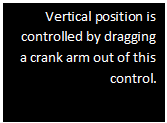



![]()







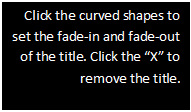

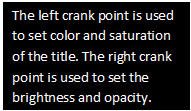

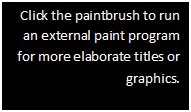

When the paintbrush is clicked, the titling program
Paint.NET (or GIMP for Mac)
is opened with a blank .png file set to
the frame size of the project settings. After creating your overlay graphic,
save the .png file and Raylight Cutter will
superimpose it over the selected shot using the transparency channel of the .png file. The fade-in and fade out controls may be used to
fade the graphic in and out.
Exporting
and Preparing your Project
for Presentation
to be written
